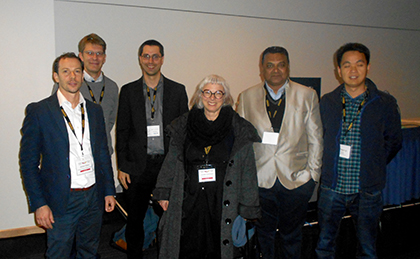Connecting globally to understand mineral systems.
South Australia hosts some of the world’s most significant iron oxide – copper–gold (IOCG) deposits. Since the discovery of Olympic Dam, IOCG deposits have been recognised elsewhere in the Gawler Craton and in a number of terranes worldwide resulting in a burgeoning appreciation of IOCG and affiliated deposit styles. The Geological Survey of South Australia (GSSA) is actively researching and promoting the state’s potential for further IOCG discoveries.

Delegates at GAC-MAC-IAH 2019, Quebec City. L–R: Adrian Fabris (Geological Survey of South Australia), Tobias Schlegel (Institute of Applied Mineralogy and Economic Geology), Jean-François Montreuil (Red Pine Exploration), Louise Corriveau (Geological Survey of Canada), Raju Sunder (CSIR-National Geophysical Research Institute), Dr. Xin-Fu Zhao (China University of Geosciences). (Photo 417825)
In May 2019 Adrian Fabris represented the GSSA at Canada’s largest geological convention, GAC-MAC-IAH 2019. Held in Quebec City, the conference covered topics ranging from mineral deposit understanding to ‘BIG data’, marine geoscience, planetary sciences to geoheritage.
A short course and symposia were dedicated to IOCG and affiliated deposits. Adrian shared understanding of South Australia’s world-renowned Olympic Cu-Au Province and learnt about an emerging appreciation of IOCG and affiliated deposit styles that crop out in northwestern Canada’s Great Bear Magmatic Zone. Canada’s remarkable exposure resulting from a relatively recent glaciation allows for detailed observation and description of these mineral systems and has resulted in an alteration model for IOCG deposits that explains many of the variants seen in Australia and worldwide.
Examples from Canada, China, Sweden, India, United States and Australia were discussed. The tectonic setting of several IOCG provenances were described as being post-subduction and in an extensional regime at the time of mineralisation. A key message that came through multiple presentations was that while the hematite-breccia style of deposits in South Australia are the most economically significant, the process that forms these deposits can also generate a wide range of economic deposits with significant quantities of rare earth elements, Ag, Bi, Co, Mo, Ni and U in addition to Cu, Au and Fe. For South Australia, the understanding of the breadth of deposits that can be expected in IOCG systems provides expectation of considerable untapped potential in our state, and underlines a need for a more diverse exploration model and approach.
Following on from the convention two GSSA papers by Laz Katona and Adrian Fabris – Defining geophysical signatures of IOCG deposits; and Geochemical characteristics of IOCG systems – will be published in the Geological Association of Canada’s Short Course Notes series. A complementary review on the Olympic Cu–Au Province by Anthony Reid has been published in Minerals doi.org/10.3390/min9060371 (open access).
IOCG Mineral Systems Workshop
On 2–3 December 2019, the GSSA will host a free, two-day IOCG Mineral Systems Workshop for explorers at the South Australia Drill Core Reference Library. Alteration facies and their application to mapping the mineral system, lithospheric- to deposit-scale footprints, and key deposit characteristics will be discussed. Keynote speaker, Dr Louise Corriveau from the Geological Survey of Canada, will contribute her wealth of knowledge on progressive alteration related to IOCG systems in the Great Bear Province. Drill core covering the range of South Australia’s IOCG deposits will be on display. Register now.
– Adrian Fabris, August 2019


